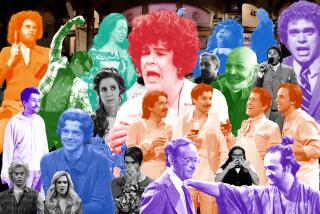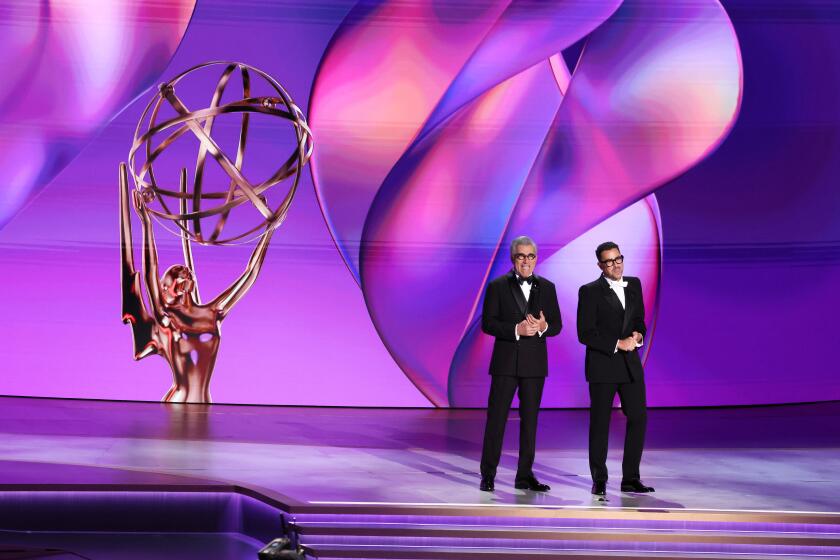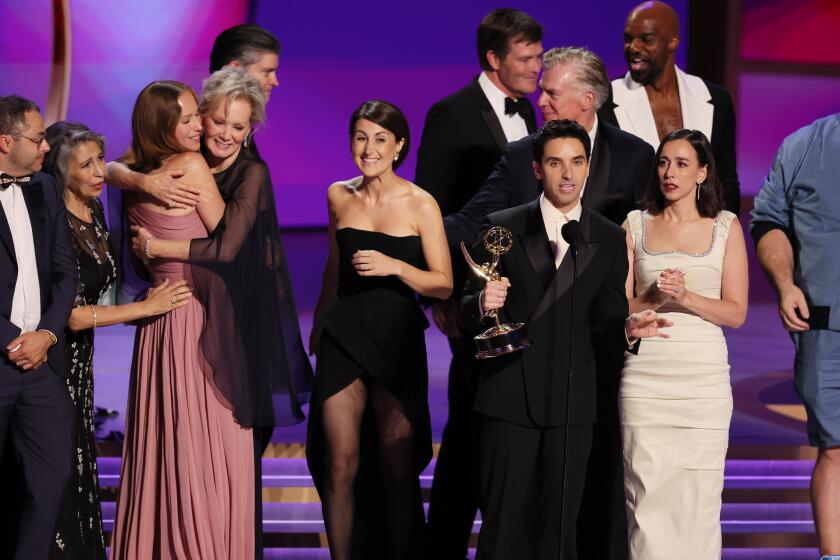Emmy-nominated drama and comedy writers pinpoint the scene that made it all work
- Share via
The most important scene in a TV episode isn’t always clear-cut: Is it when a character makes a big decision? Is it a small call-back moment to an earlier season? Does it come as an unplanned surprise — even to the writer? The answer for all of this year’s drama and comedy series Emmy nominees is … yes, yes and yes! Here’s how each of the 14 nominated writers in those categories singled out their most important scenes to The Envelope.
Drama Nominees
Series: “Better Call Saul
Episode: “Bagman”
Here’s the key: Having fled through the desert carrying Lalo’s money, Jimmy makes a decision to face his pursuer for a final confrontation so he can go home to Kim.
The big deal: “We wanted to put Jimmy through some trauma, so what does he take from it?” says writer Gordon Smith. “He’s willing [to do what it takes] to survive and will do anything to get back to Kim. He finds the strength to draw out this dangerous person and put himself in the most vulnerable place.”
Series: “Better Call Saul”
Episode: “Bad Choice Road”
Here’s the key: Dangerously unpredictable Lalo Salamanca demands the truth from Jimmy after his experience in the desert, but a quick-thinking Kim stands up for her husband, ultimately saving both of their lives.
The big deal: “The series has two parallel storylines, and this is where they cross,” says writer Thomas Schnauz. “Lalo is a wild card and has taken people out before. [Kim’s] death could be coming from anywhere. But she turns the tables and ends up dominating the scene — defending what she knows is a lie in defense of a different truth.”
Series: “Ozark”
Episode: “Fire Pink”
Here’s the key: Wendy’s bipolar brother, Ben, breaks out of a psychiatric hospital and unleashes a stream-of-consciousness monologue while talking to a taxi driver.
The big deal: “Tom Pelphrey (Ben) is an incredible actor with extraordinary access to the mental sickness we were trying to get in,” says writer Miki Johnson. “His performance is so indelible, and if we had hired a different actor, I would not have written the monologue at all. I was inspired by his character.”
Series: “Ozark”
Episode: “Boss Fight”
Here’s the key: Kidnapped by the Navarro cartel, an imprisoned, tortured Marty Byrd finally unleashes his anger at his tormentors rather than continue cowering.
The big deal: “Marty is kind of forced into therapy by torture, to face his own wants and desires and attitude,” says writer John Shiban. “He says things you wouldn’t want to say to a drug lord — and Jason Bateman nails it, coming out like a wounded animal to rage at this guy. He’s got his mojo back.”
Series: “Ozark
Episode: “All In”
Here’s the key: Marty lies down next to Wendy in bed, saying she was right all along, they need to burrow into the heart of what’s going on.
The big deal: It brings the story full circle, says writer Chris Mundy. “In Season 1 they’d lost a baby, and it was a call back to that moment, which led them into money laundering in the first place. We wanted it to bounce off the flashback and be a direct answer: Marty has come around to her point of view.”
Series: “Succession”
Episode: “This Is Not for Tears”
Here’s the key: Logan’s family and executives discuss who should take the fall for misdeeds in the company that have recently gone public.
The big deal: “The stakes were clear: They were discussing who would go to jail, and that was a meaty scene — a key building-block scene that people who enjoy the show would enjoy seeing,” says series creator and writer Jesse Armstrong, who singles out Mark Mylod’s direction of the episode as key to making it work.
Series: “The Crown”
Episode: “Aberfan”
Here’s the key: Queen Elizabeth II fumbles in her response to a coal-mining disaster in Wales, and needs coaching from Prime Minister Harold Wilson.
The big deal: “The queen’s response to Aberfan is her biggest regret for the first 50 years of being a queen,” says creator and writer Peter Morgan. “She feels her failure to respond reveals her biggest flaws as a human being: lack of empathy and social sophistication. The prime minister manages her delicately and puts her back together.”
Comedy Nominees
Series: “The Great”
Episode: “The Great”
Here’s the key: Post-wedding night, Peter and Catherine share breakfast together.
The big deal: “The most fundamental aspect of Catherine’s character is her deranged optimism, and we hadn’t yet seen that,” says creator-writer Tony McNamara. “We’d only seen her as a romantic idealist. This is the first proper give-and-take between the two of them. It sets him up as not just a crazy tyrant; there are aspects of him that are more like a little boy. It makes their relationship more interesting.”
Series: “What We Do in the Shadows”
Episode: “On the Run”
Here’s the key: Old enemy Jim tracks vampire Laszlo to a bar where he’s in “disguise” as Jackie Daytona, but doesn’t recognize him immediately … because “Jackie” keeps a toothpick in his mouth and wears blue jeans.
The big deal: “It’s so silly and absurd, and that was the tone I was going for: this small-town type story, with the added layer of pure stupidity of Jim (Mark Hamill), who’s fooled by a toothpick,” says writer Stefani Robinson. “Watching Luke Skywalker play this specific kind of vampire was a joy.”
Series: “What We Do in the Shadows”
Episode: “Collaboration”
Here’s the key: Human familiar Guillermo leaves Nandor in the hopes his new boss will make him a vampire.
The big deal: “It’s the first time Guillermo really pins Nandor down to make this impossible request [to become a vampire], and Nandor does not want to answer this question,” says Sam Johnson, who wrote the episode with Chris Marcil. “It moves the arc of the series — there’s a weird almost romantic comedy between those two.”
Series: “What We Do in the Shadows”
Episode: “Ghosts”
Here’s the key: During a séance, the vampires are confronted by their dead spirits; one infests a doll.
The big deal: “It was technically hard to do, having three actors acting opposite themselves,” says writer Paul Simms. “Seeing them do it was amazing; it was shot in so many pieces that it wasn’t until the final edit that it all came together. I ignored all my self-censoring about how hard this would be to do — and wrote it like a challenge.”
Series: “Schitt’s Creek”
Episode: “The Presidential Suite”
Here’s the key: Alexis and Ted break up so they can continue their separate careers.
The big deal: “There’s a very long game being played, a slow burn for many characters,” says David West Read. “The universe has made it hard for them to be the people they want to be — and to be together. So, since they care about each other, they let each other go.”
Series: “Schitt’s Creek”
Episode: “Happy Ending”
Here’s the key: David and Patrick get married, with Moira officiating.
The big deal: “Moira is challenged with an emotional revelation she never had before,” says writer Daniel Levy. “This woman had held it together for all of the seasons of our show but couldn’t anymore. And then there were David’s vows — he’d been shut off and closed down, but now he could speak his heart. He decided not to make a joke or deflect with sarcasm.”
Series: “The Good Place”
Episode: “Whenever You’re Ready”
Here’s the key: After finally making it to the Good Place and living in paradise, Chidi decides to move on to nonexistence and provides Eleanor with another way to look at death.
The big deal: “He suggests that death is like returning to the ocean as a wave, and that Buddhist understanding of death was probably the most important scene,” says creator-writer Michael Schur. “That scene had to do a lot of work, and was the one I was most concerned about getting right.”
More to Read
The complete guide to home viewing
Get Screen Gab for everything about the TV shows and streaming movies everyone’s talking about.
You may occasionally receive promotional content from the Los Angeles Times.






